Learn the differences between leads, prospects, and opportunities. Understand how to turn leads into prospects and opportunities.
Referral marketing is a lead generation strategy in which businesses systematically incentivize their customers to recommend their products or services to others. Common incentives range from store discounts to gifts like branded apparel. These rewards turn your happy customers into passionate sales reps who proactively find and sing your praises to people they think would benefit from your offering, thus generating high-quality leads for your business at a low cost.
Referral marketing involves offering your customers some form of reward in return for successful referrals. Success is often defined as the lead becoming a paying customer; however, different referral programs have different ideas of what makes a successful referral. For instance, a company might run a referral program in which customers are awarded $50 if they get someone to sign up for a webinar or a free trial. It all depends on your referral program’s goal.
There are many referral marketing strategies businesses use. Here are the most popular:
Marketers running referral marketing campaigns rely heavily on referral program software. These tools help them design the referral program, create unique referral links, track those links, measure performance metrics, and promote the program to customers. And salespeople rely on CRM software to track and pursue the leads generated from the program.
It’s worth noting that, although incentives are essential to a successful referral marketing strategy, they don’t have to be monetary or physical rewards like discounts or gifts. An incentive can be as simple as the satisfying feeling one gets when sharing a service they love with their friends. This type of cost-free incentive is used in many review-based or direct referral marketing strategies, two of the several types we discuss below.
Referral marketing can pose several challenges to sellers and marketers, including pinpointing the perfect incentive, managing referral attributions and payouts, and keeping your customers aware of the program. That said, there are strategies for overcoming these, which we’ll discuss, and these roadblocks by no means outweigh the many benefits of referral marketing — its low cost, its ability to generate high-quality leads, and its tendency to turn customers into loyal fans.
There are five main types of referral marketing: direct, reviews, incentive-based, email, and social media. Let’s briefly go over each one. Many businesses use a combination of these different types of referral marketing to expand their reach and hit their marketing goals. If you’re just starting out, we recommend picking one or two to master first.
Direct referral marketing is when you directly ask a customer for a referral, without mentioning a reward. An example is a sales rep asking a newly converted customer if they know of anyone in their network who would benefit from their service. This direct request happens in person, over the phone, or through email. Asking for the referral is usually the job of the customer success manager, or whichever employee has the best relationship with the customer.
Review referral marketing is when you ask customers to leave reviews of your business. Brands accomplish this through a combination of providing a great customer experience and asking buyers to leave reviews. Sometimes they’ll sweeten the pot with a reward for those who do. To make it easy to leave reviews, and for leads to find them, businesses create profiles on review sites that are popular in their industry, such as Google My Business, Yelp, Facebook, or G2.
Incentive-based programs offer customers something in return for successful conversions. That might be a discount for your store, a cash reward, or a non-monetary reward like a brand-related gift or reward points that can be cashed in later. Some incentive-based plans offer dual rewards, meaning both the old and the referred lead/customer get the reward.
Email referral marketing refers to referral programs and offers communicated to customers over email. Often, a company will set up an email campaign meant to teach customers about the referral program. Some referral marketing software enables you to set up automated emails that auto-send to customers when they perform a specified action, such as buying a product from your store, that signals they’re probably in the mood to recommend your brand.
Social media referrals take place on a social media platform. Companies incentivize customers to share content related to the brand with their audience, thus becoming micro-influencers (talk about reach!). A t-shirt company could offer customers a reward if customers post a picture of themselves in the shirt on Instagram with a specified hashtag and unique link.
Regardless of which type(s) of referral marketing you use, you’ll gain an amazing advantage within your market.
From helping you improve lead generation to increasing your closing and retention rates, referral marketing offers tremendous benefits. It helps you attract leads and customers with high customer lifetime values, it’s a highly affordable strategy, and it turns the customers doing the referring into raving fans.
These three benefits will help you reach your marketing and sales goals, from increasing net revenue to improving your customer retention rate.
Below are eight of the most powerful referral marketing strategies, along with illustrative examples to show you these strategies in practice. Read on for some great ideas involving creating, managing, and promoting various types of referral marketing campaigns.
To start a referral reward program, where your customers win rewards for getting you referrals, you’ll need to follow several steps. First, define the goal of the program. Is it to get sign-ups for a newsletter, or win converted customers? This will help you determine what counts as a successful referral. Next, pick your reward, whether that’s discounts, gifts, free products, or, as Morning Brew has done, an arcade-like points system where customers can win branded swag:
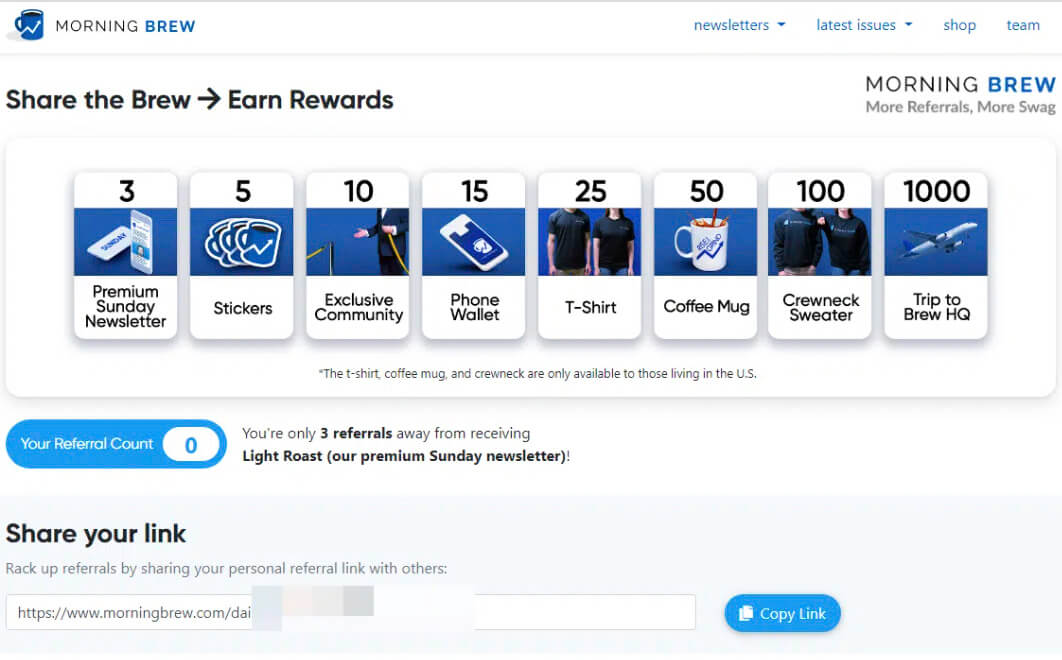
After deciding on a reward system, design your program’s landing page, where customers can learn about the program and rewards. It’s best to start the page with the reward in big lettering, then describe the rules of the game. Underneath, provide a unique URL link and other ways to share the offer with friends and peers.
You’ll also have to create sales messaging that goes along with the link, as well as a landing page where the referred lead can learn about your offer. To help you do all of this, look for suitable referral program software. These platforms also help you manage your program, track your referral links, and analyze performance metrics. Once you’ve set it up, you can start promoting your program to customers through social media, email, and other channels.
If you want your customers to recommend your brand, make it easy for them to do it. Give them a unique referral URL they can copy and send to friends and peers. Also, empower them to send this code through various channels — text, social media apps, and email.
For example, check out how many ways Robinhood gives their customers to refer a friend:
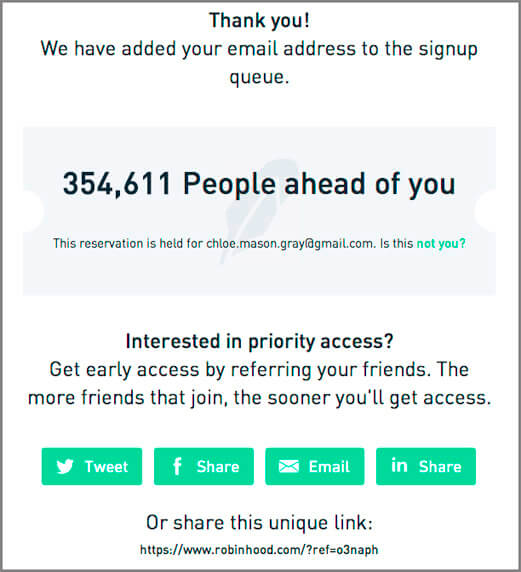
They provide a special link as well as email and social media buttons that will automatically open up the specified platform and enable customers to easily share the offer with specific peers, or even their entire network.
You can also use your referral channel to incentivize a certain type of interaction between your customers and the people they’re trying to refer. For example, by making customers download a referral pass to their Apple or Google Wallet, you’ll likely facilitate more in-person interactions. Customers would actually show the pass to their friends and family so they could scan it. Though limited in reach, this likely has a higher conversion rate than email or text messages.
Perhaps that’s why Remi employs the Wallet Pass method on their referral page:
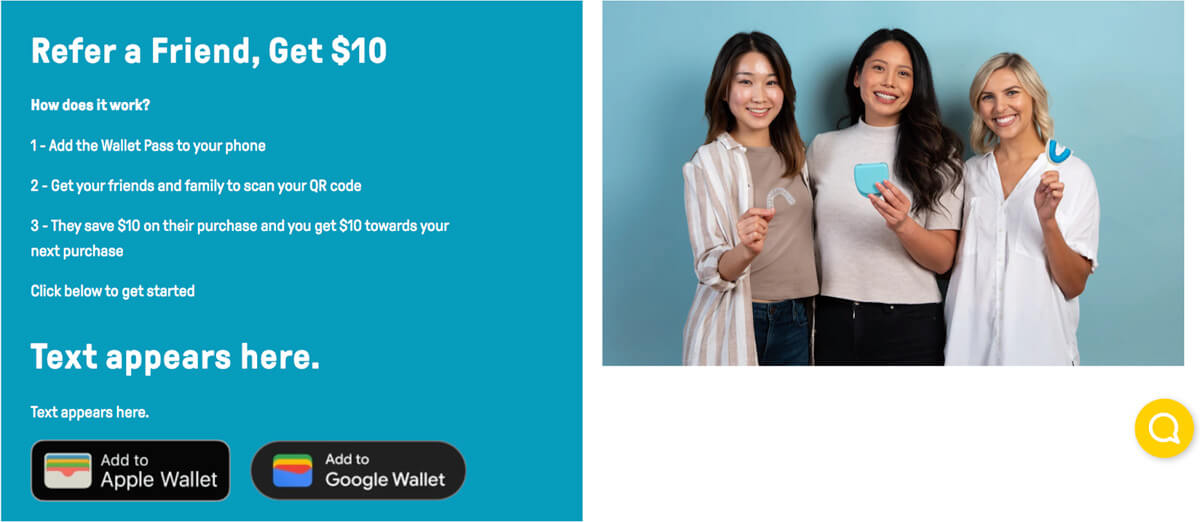
Generally, though, the best approach is to give your customers as many options as possible for sharing your brand with their peers. This ensures each of your customers can spread the word in whichever way they prefer. Lastly, consider creating pre-written message templates that customers can easily send to friends and family. Most referral program software will offer this function.
Consider sending out customer surveys to generate positive online reviews from your customers. In the survey, ask questions about the customer’s experience, which you can use to guide your business strategy. You can send these to your customers through email, as Ally Bank does:
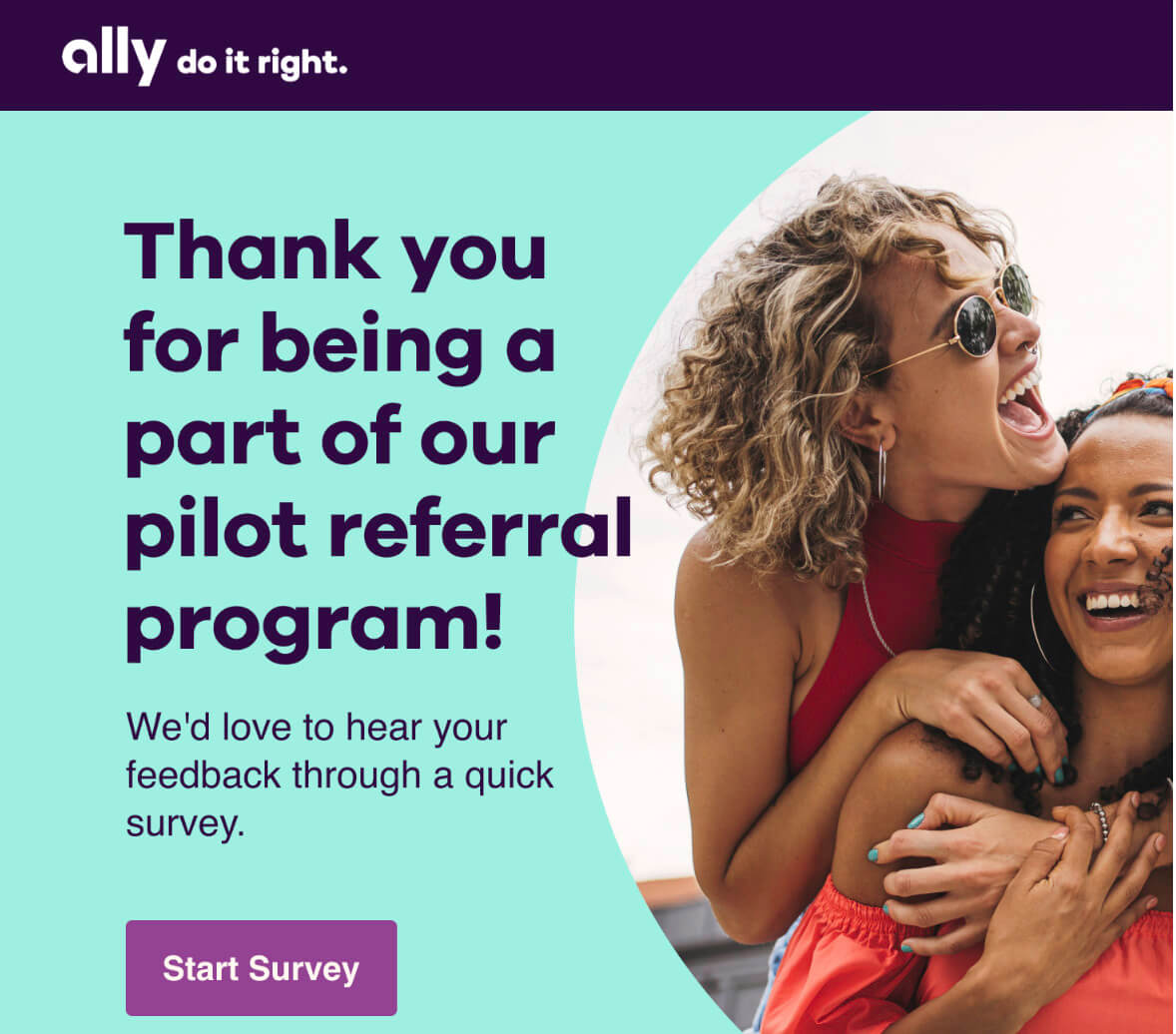
At the end of the survey, include a question that asks the customer if they’d be willing to submit a review to your review platform of choice. That could be Google, Yelp, G2, or whichever one your leads often visit. If the customer has been responding positively to your questions, it’s likely they’ll be in the mood to write a positive review. They’re already in an appreciative mindset.
Another great referral marketing strategy is to turn your happy customers into brand ambassadors who promote your brand across social media using a unique ambassador code. For example, a customer could post pictures of themselves using your product on their social profiles.
To illustrate, here’s an Instagram post from one of Coca-Cola’s Campus Ambassadors:
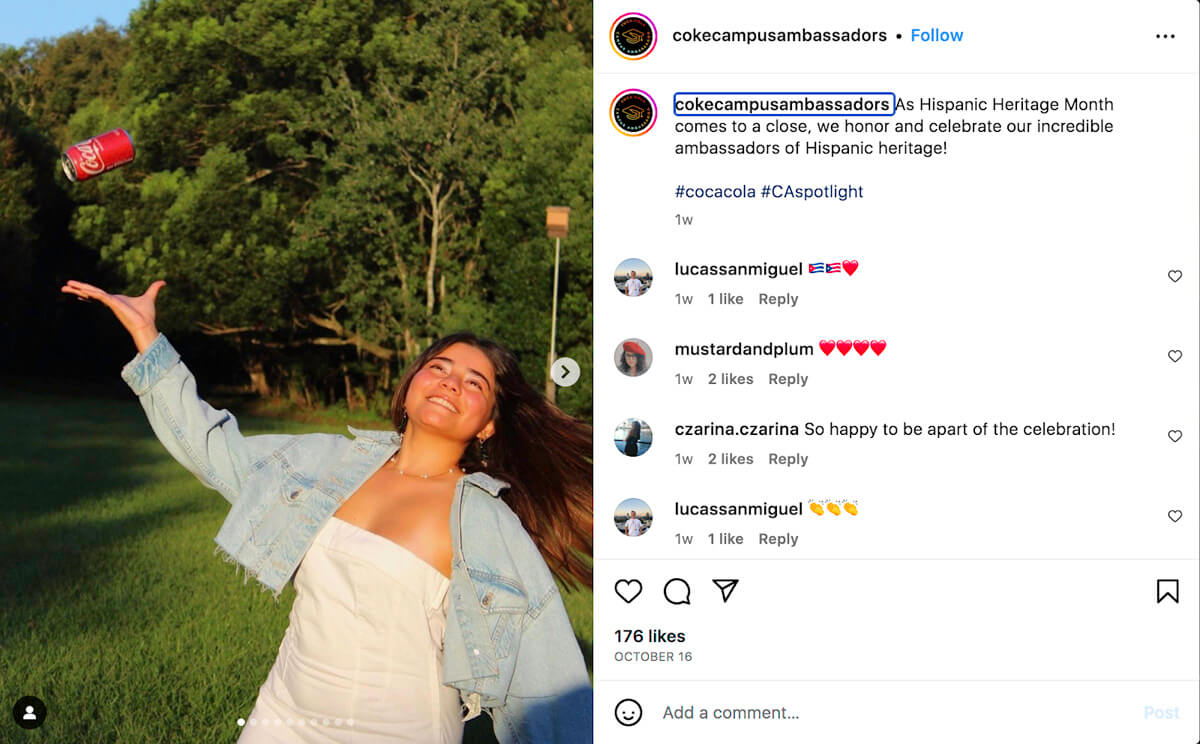
Brand ambassador programs are a great way to tap into large networks without doing much work at all, aside from rewarding your ambassadors when they hit certain milestones like reaching a certain level of engagement on their posts. To find your brand ambassadors, consider using social listening tools to spot people who love your brand. Or, send out customer surveys and ask the people who give you the best ratings.
Play to your customers’ generosity by giving a reward not only to them, but also to the person they refer, as the YMCA has done below by offering 20% off to both parties:
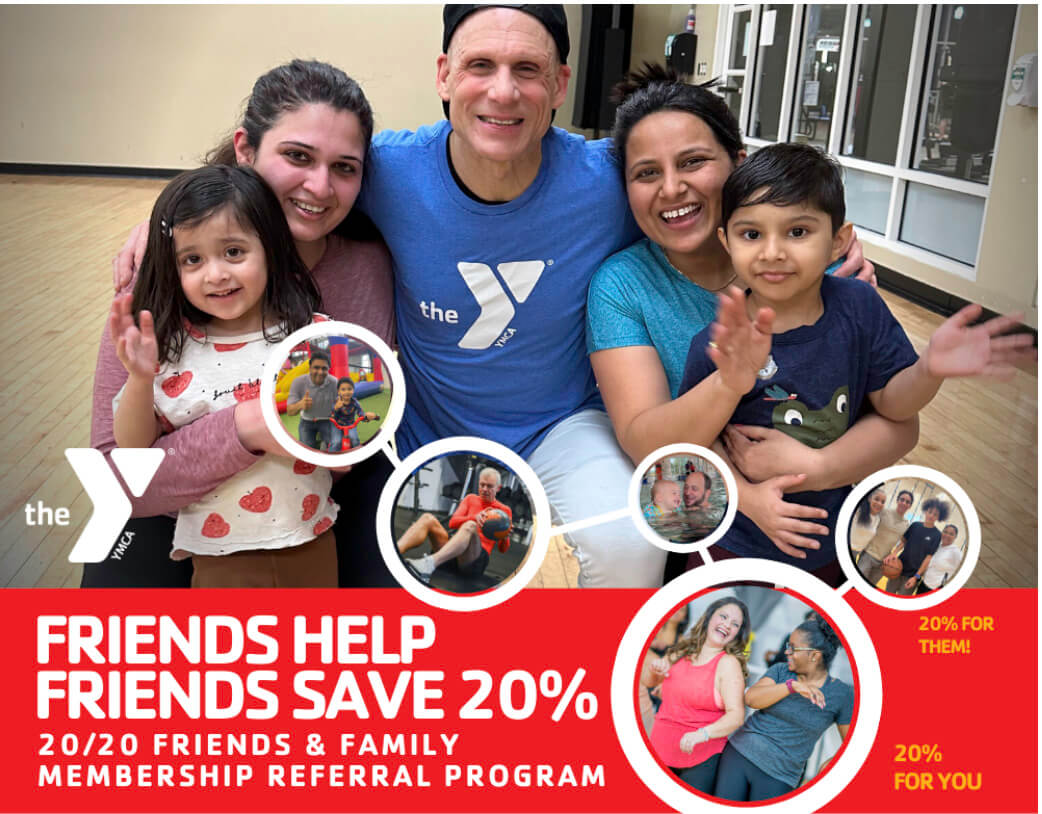
This increases the chances that customers will want to go out and promote your business. It’s much more fun to help their friends and peers get a good deal than to just secure one for themselves. Plus, with dual programs, there’s a greater chance that the referred lead buys from your company since they have an added incentive to do so.
Just like with products, customers often need to see a referral program several times before they’ll opt-in. Consider creating a series of 3–4 emails that educate your customers about your referral program, including how to sign up, the conditions that need to be met for a successful referral, how to share the offer with friends, and what rewards they can win.
For example, here’s an email from Capital One promoting a chance to win up to $500:
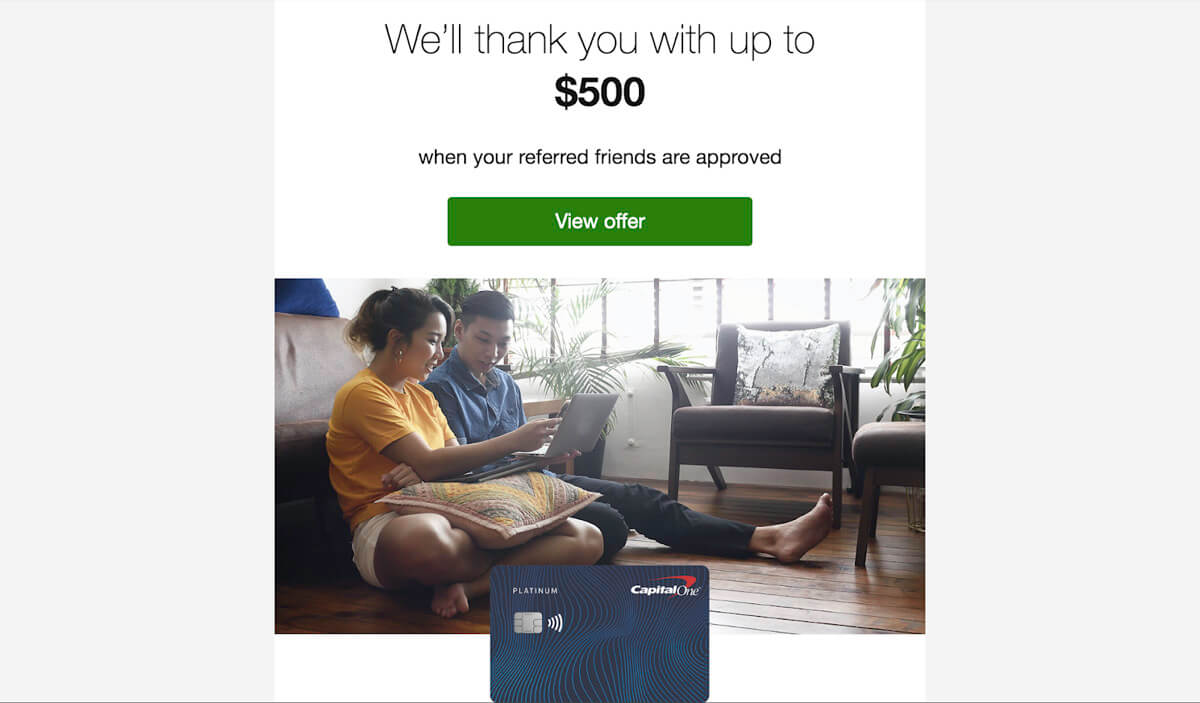
In this case, recipients can click on the green “View offer” button and learn more about the program. On the landing webpage, customers will find a link that they can easily share with friends. Check out our email nurturing article to learn how to create stellar campaigns. It’s technically meant for email campaigns that close sales deals, but the information is applicable to anyone trying to use email to close anything, including a referral program sign-up.
Transactional emails are invoice receipts, billing reminders, technical support messages, and other emails that are primarily for something other than marketing or sales. But that doesn’t mean you use them to promote your referral program. Consider subtly mentioning it at the bottom of these emails, as Cloudways has done in the email below:
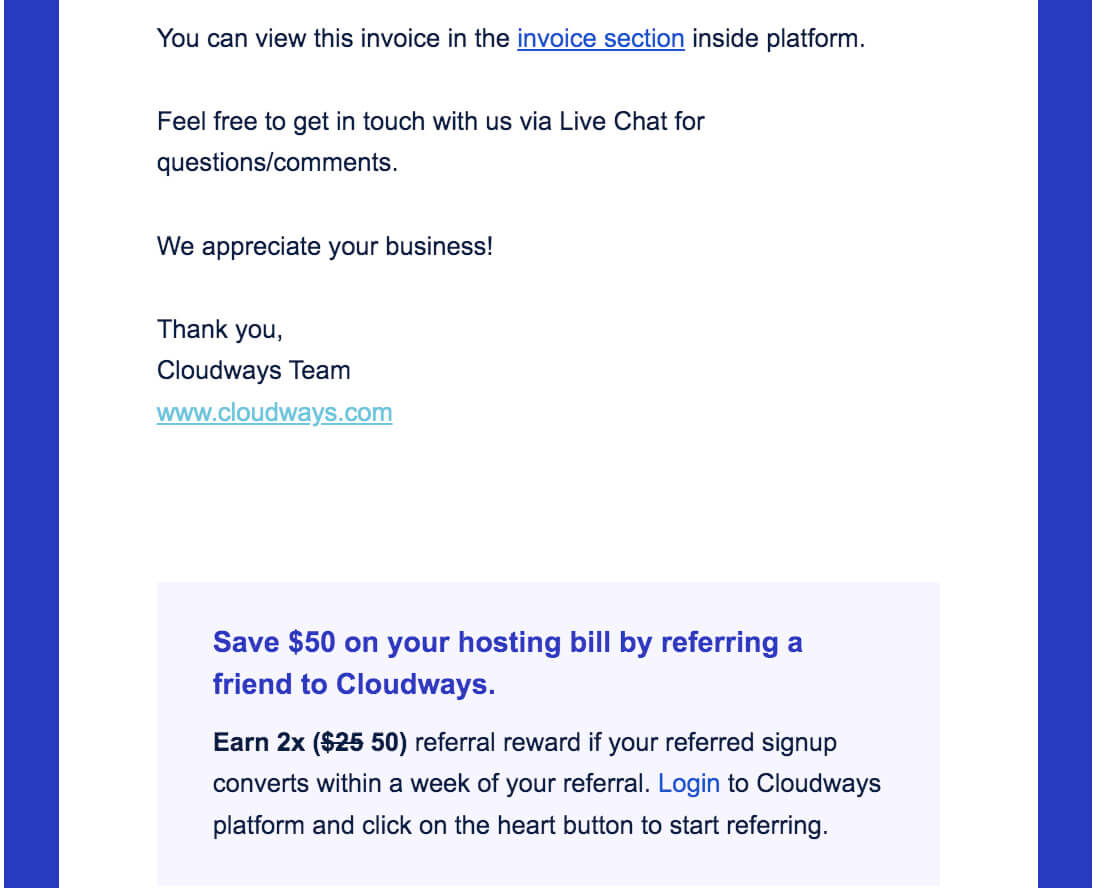
That way, after someone reads the email body copy, they’ll see the reward they will potentially gain. In Cloudways’ case, that’s $50 off their hosting bill when they refer a friend. It’s fitting that this reward is attached to the invoice receipt, since billing and costs are definitely two things on the customer’s mind in that moment. In sum, promoting referral programs at the bottom of transactional emails is a great way to make them work towards winning you new customers.
Consider asking for referrals at the end of every sale. This is low-hanging fruit. Make it a standard practice of your sales team by incorporating it into the sales process. To ensure that reps never forget to ask, set up an auto-reminder in your CRM that lets them know when it’s time to request the referral. Ask something along the lines of “Do you know anyone who might find our solution helpful?” If they like your service and have someone in mind, they’ll help you out.
If you’re in B2B sales, you could even do some preliminary research and find a person they’re connected with on LinkedIn to whom you’d like an introduction. If the customer agrees, have an email template ready that they can use to facilitate the introduction. This makes their job easier and ensures that the referred lead gets pre-approved messaging.
All effective marketing strategies pose challenges. In the case of referral marketing, those are finding the right incentive, tracking referrals and dispensing rewards, and maintaining your program’s momentum. Let’s take a closer look at each, as well as how to overcome them.
Often, challenges like the above seem larger than they are in reality, so don’t let them stop you from taking action. The benefits of referral marketing are too big to miss out on.
From running reward programs to working with brand ambassadors, referral marketing strategies take advantage of your customer base’s love for your brand in order to increase lead generation and sales. The best part is that the leads it generates come to you already trusting in your brand, since they trust the people who recommended you. For other ways to get referrals, check out our article on the top ways to generate high-quality referrals.